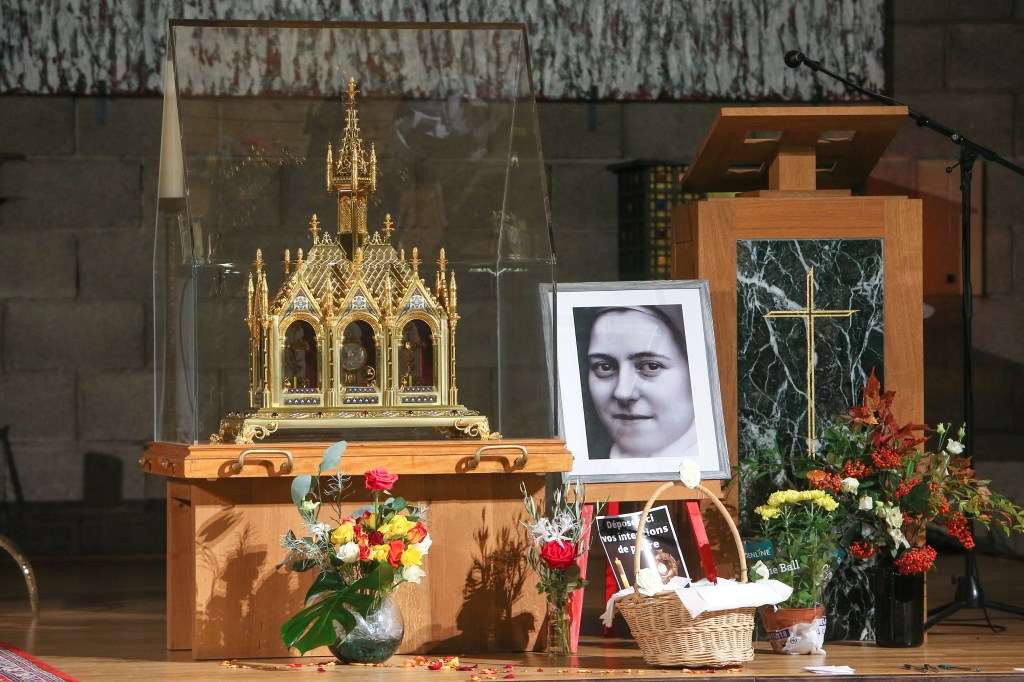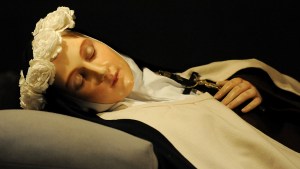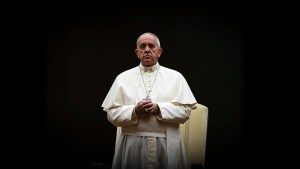Relics of St. Thérèse of Lisieux are on a pilgrimage around the world that has aroused great interest since it began in the 1990s. They will be making a stopover in Rome from June 6 to 16, 2023, based at the Russicum, the Slavic Jesuit College, which includes Russian and Ukrainian religious. The reliquary of the French saint, after being presented in the Philippines and Germany, will be present in St. Peter’s Square for the general audience with Pope Francis on June 7. The relics have already been at a general audience before, with Benedict XVI on November 14, 2007.

Fr. François-Marie Léthel, a religious of the Discalced Carmelite Order, is a professor of dogmatic and spiritual theology at the Teresianum, his spiritual family’s university in Rome. This specialist in Teresian spirituality was invited by Benedict XVI to preach the Lenten retreat for the Roman Curia in 2011. In this interview, he talks to I.MEDIA about the arrival of the relics of Thérèse de Lisieux in Rome in 2023, the 150th anniversary of her birth and the centenary of her beatification.
What is the significance of the return of these Thérèse relics to Rome?
Fr. Léthel: The pilgrimage of the relics was begun in the 1990s, in the context of the preparation for the declaration of Thérèse of Lisieux as a Doctor of the Church. We have many testimonies to the effect it has had on the faithful: these relics are like a “magnet” that attracts people. We can see that on these occasions, many people come, go to confession, draw closer to the Church … For this stage in Rome, the relics will be based at the church of Sant’Antonio abate, which is the church of the Russicum.
From there, they will be taken to different locations, notably to the Holy Father for the general audience, to the church of St. Louis of the French, and to the Teresianum. It will be a joyful moment, a moment of evangelization, at a time when the Church is going through a difficult period, particularly here in Rome. I truly believe that Thérèse is one of the most beloved saints in the world, beyond all borders. So this will be an important moment, and, for Pope Francis, a moment of spiritual consolation. He’s very fond of “little Thérèse!”
What is Pope Francis’ connection with Thérèse? Is he inspired in the way he carries out his ministry by her “little way?”
Fr. Léthel: The Pope is deeply rooted in Latin American popular devotion, and is particularly familiar with the tradition of the “novena of roses” linked to the spirituality of Thérèse.
It’s worth rereading one of Pope Francis’ most beautiful texts, his apostolic exhortation Gaudete et exsultate, on the call to holiness in today’s world. Thérèse is quoted several times, in particular her concept of holiness being accessible to all, that famous “little way!” The Pope reacts strongly against Pelagianism, a vision of holiness centered on heroic effort. Holiness requires first and foremost leaving room for the primacy of grace.
Thérèse therefore teaches a path to holiness that is accessible to all, found in the small things, and in accepting one’s own weaknesses. Thérèse’s teaching is wonderfully in tune with the teachings of the Second Vatican Council. The two most important chapters of Lumen Gentium — chapter 5 on the universal call to holiness in all states of life, and chapter 8 on holiness fully realized in Mary — echo Thérèse’s intuitions on a holiness accessible to all, whether for a mother, a nun, or a priest.
With Thérèse’s spirituality, even the greatest sinners can have access to holiness. Just think of Jacques Fesch, condemned to death and executed, but who could become a saint, like the Good Thief.
This period of the synodal process is causing a certain amount of agitation within the Church. Can Thérèse’s spiritual heritage help to refocus our gaze on Jesus?
Fr. Léthel: I think we can indeed consider Thérèse as a “patroness of synodality.” The idea of Pope Francis is to open up dialogue, to free up speech so that everyone can express themselves. But then, be careful, his aim is to refocus on Jesus: the central subject is not the reform of structures.
As the Council said that the Church is both holy and always called to purify itself. Thérèse has some magnificent pages in Story of a Soul on this theme of the pilgrim Church on the move. She comments on the words of the Song of Solomon when the bride says “Draw me after you! We will run to the smell of your perfumes.” That’s what her prayer is, in reference to the Church, the bride of Christ. This “we will run” encompasses the whole Church, the whole of humanity. It corresponds to what Pope Francis says, when he explains that evangelization is achieved not by proselytizing but by attraction, by drawing people to Jesus.
In this way, Thérèse has drawn thousands of people in her wake. As Synod participants get to know her, she will help refocus everything on Jesus.
Is her spirituality “disarming” for the more intellectual?
Fr. Léthel: Yes, her spirituality can help even the most intellectuals find their way to Jesus. Pope Benedict XVI, a theologian, was very fond of little Thérèse, and often suggested her as an example to theologians. In his catechesis on April 6, 2011, a few days after the retreat I preached for the Roman Curia, he invited us to take her littleness as our model. He showed that her loving knowledge of the mystery of Jesus was not opposed to a scientific knowledge of Jesus, because Thérèse was very much centered on Sacred Scripture.
Benedict XVI was a great intellectual, but also a great man of the spirit who appreciated Thérèse’s humility. He saw great theological value in her book Story of a Soul, which is a true marvel that the Church has always recommended.
Her family was highlighted at the canonization of her parents. Is this an encouragement for today’s families?
Fr. Léthel: Her parents, Louis and Zélie, were canonized by Pope Francis during the Synod on the Family. And her sister Léonie, who was the simplest and poorest of the family, with difficulties of character and psychological problems, is also on her way to sainthood. The other sisters were good Carmelite nuns, but have no reputation for sanctity, and there will be no process of beatification for them.
Thérèse’s testimony about her childhood is very interesting for us today. She talks in particular about the love of her parents, the importance for a child to be loved by a father and a mother, and how the death of her mother when she was 4 wounded her.
At the age of 10, she developed a psychological illness brought on by her sister Pauline’s entry into the Carmelite Order. She considered her to be her second mother, so this caused her to fall apart, a very serious illness. She was healed by Mary’s smile. It was only with the grace of Christmas 1886 that she was freed from her hypersensitivity. Then she began what she called her “race of giants,” until the end of her life: a vertiginous progression towards sanctity.
Thérèse is the saint of fragility. Today, with wars, pandemics and natural disasters, we have a growing sense of the fragility of human life. This fragility, which naturally frightens us, becomes, with Thérèse, the grace of graces. Accepting one’s own fragility opens the way to holiness, and ultimately to true joy.
100 years after her beatification, are we still discovering new aspects of her spirituality?
Fr. Léthel: Thérèse is tirelessly read, studied, and recognized beyond the borders of the Church. I had the opportunity to visit Egypt, in Cairo, where we have a basilica dedicated to St. Thérèse. It’s mainly attended by Orthodox Copts and Muslims. She works miracles for Muslims too! So she’s loved far beyond the Catholic world.
Her humility and her testimony of love have earned her recognition by UNESCO as an important figure for all humanity. There are historical and literary approaches to her, but theologians also need to take her seriously! In 1997, at the request of John Paul II, I worked on the Positio for Thérèse’s being declared a Doctor of the Church. It was a document of almost 1,000 pages designed to show the whole Church that Thérèse deserved to be given that title.
She’s an intuitive genius: She doesn’t make long arguments in the manner of St. Thomas Aquinas. Rather, she offers spiritual insights, always based on the Word of God and the Eucharist. She offers new insights into mercy, notably in her prayer at the age of 14 for her “first child,” the criminal Henri Pranzini. Faced with this most desperate of situations — that of a man condemned to death who had not repented — she prayed to save him from Hell at all costs…
She develops a new experience of mercy, with the discovery of this little way, the way of holiness for all, a positive perception of fragility. It’s impressive to see that as early as 1898, a first edition of Story of a Soul was published, but it wasn’t until 1956 that an authentic edition based on the manuscripts was published. And then it was only in 1992 that her Collected Works were published. It has had an extraordinary impact on the people of God, and Story of a Soul has been published in every language.
Here in Rome, I have received students from all over the world. I’ve seen that with Thérèse, there’s no problem of inculturation. She is everywhere, in all cultures, in Europe, Africa, Asia, Latin America … Like St. Francis of Assisi, she touches something essential in the human heart.
Does her missionary influence also echo Pope Francis’ invitations to look to the wider world, not to withdraw into oneself?
Fr. Léthel: Yes, Pope Francis regularly speaks out against what he calls a “self-referential Church.” On the contrary, he wants to promote a Christocentric Church: the center is Jesus, not ourselves.
Thérèse was chosen as patron saint of the missions. We must remember the historical context of the 19th century. It was the golden age of atheism, which was then structured as a philosophical system with Marx and Nietzsche. Thérèse herself lived through a terrible crisis, a trial “against faith” without losing it. “Jesus allowed my soul to be invaded by the thickest darkness,” she writes in a deeply moving manuscript. She therefore feels like a sister to unbelievers, whom she calls “my brothers.” She prays for them with complete confidence.
But the 19th century was also the greatest missionary century, with many martyrs. In Vietnam alone, there are thought to have been 150,000 martyrs. The Carmelite monastery of Lisieux was very missionary, with foundations in Hanoi and Saigon. Thérèse was ready to leave for the Hanoi Carmel, but was prevented by illness from doing so. She was passionate about the missions, in which France played an essential role. That country provided three-quarters of the world’s missionaries: the Church had regained extraordinary vitality after the French Revolution.
At the end of her life, she received two spiritual brothers: a seminarian who was about to join the White Fathers, the Missionaries of Africa, and a young priest from the Foreign Missions of Paris, a missionary in the Far East, a region of the world that had seen many martyrs. She wrote them magnificent letters, demonstrating her missionary spirituality.
Among other examples, we can mention Bishop Ovide Charlebois, a missionary bishop in Canada’s far north. He witnessed miracles linked to Thérèse’s intercession in the evangelization of the Eskimos. He is one of the missionary bishops who, in the 1920s, asked the Pope to proclaim Thérèse Patroness of the Missions, because they saw that she brought extraordinary results.
How did her spirituality gradually spread beyond the walls of the Carmelite communities?
Fr. Léthel: The Carmelite Order has three great doctors — Teresa of Avila, John of the Cross, and Teresa of Lisieux — who have passed on their message without betraying it. Blessed Marie-Eugène of the Child Jesus, a Carmelite priest, then helped to make the spirituality of Thérèse de Lisieux better known. Pope Francis is very fond of his masterpiece, I want to see God, which he has read several times and once offered to Curia leaders – during his 2017 Christmas greetings.
He founded the Notre-Dame-de-Vie Institute, a beautiful community of consecrated people living in the lay world while fully assuming the spiritual life of the Carmelites, with two hours of prayer a day. Fr. Marie-Eugène saw Thérèse as a giant, while the Carmelites themselves didn’t see her as an extraordinary mystic, nor did they perceive her depth. Even before her beatification, Fr. Marie-Eugène saw Thérèse’s genius as a doctor of the mystical life, of a “high voltage” life of faith, hope and charity.
Can Teresian spirituality offer opportunities for rebound and meaning in a world marked by a vocational crisis and the difficulty young people have in finding their bearings?
Fr. Léthel: I’ve lived in Rome for over 40 years and worked here for 25 years in youth formation, and I’d say that 90% of our students owe their vocation to Thérèse of Lisieux. We see this everywhere, in Latin America, in India… She’s extremely attractive to religious, but can also inspire lay people, especially young couples. In this world of noise and superficiality, there’s a desire for interiority, a desire for true love. She can help everyone find a little space for silence and recollection.



